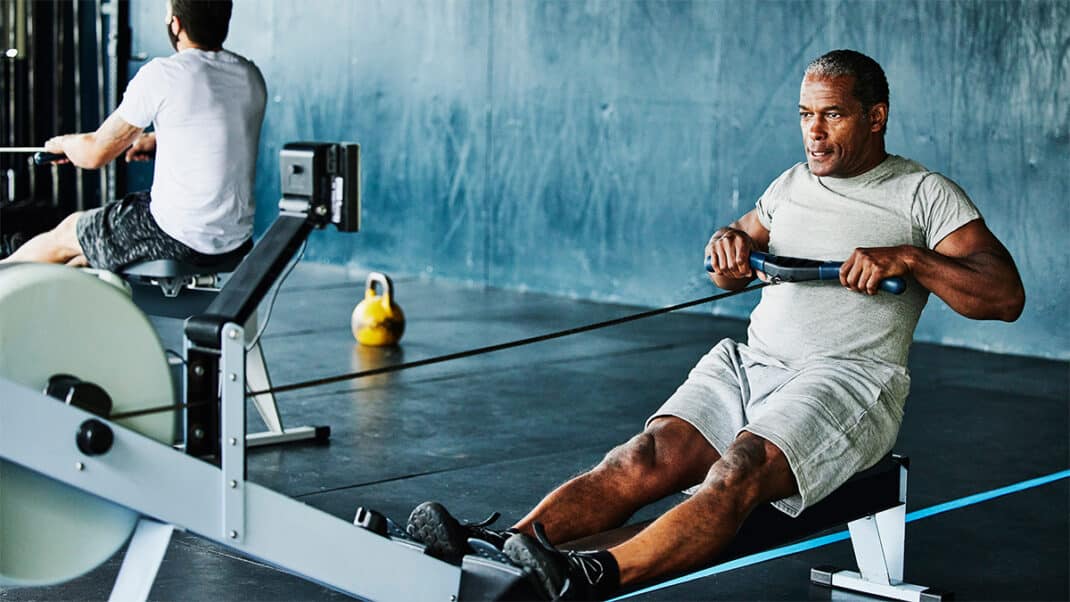Body-Weight HIIT Exercise
A new twist on an ancient workout.
Body-weight exercise (BWE) has historical roots dating back to 480 B.C.; the ancient Greeks and Romans used body-weight training to physically prepare for battle (Tomecka 2017). Today, the benefits and popularity of BWE continue to grow, although (hopefully) for different reasons! In its 2022 international fitness trends report, the American College of Sports Medicine notes that body-weight training is in the top five exercise modalities in several countries (Kercher et al. 2022). Meanwhile, high-intensity interval training is also a popular training method characterized by intervals of vigorous exercise alternating with periods of active or passive recovery. Combining these modes of training to create a body-weight HIIT exercise program has proven benefits we’ll explore below.
Body-Weight Training Defined
With body-weight exercise, people use their own body weight as resistance to perform work against gravity at varying intensities (Harrison 2010). Harrison submits that BWE provides training in a three-dimensional (i.e., multiplanar) environment. Classic examples of BWE movements include squats, lunges, pushups, jumping jacks, high knees and burpees.
Despite the adaptability and popularity of BWE, there is limited empirical evidence on the acute and chronic benefits of this training style. From a scientific standpoint, BWE is challenging to investigate since a set workload or machine does not control intensity. However, the COVID-19 pandemic has inspired many researchers to develop and test some innovative BWE protocols, which will be discussed in this article. A second major goal of this column is to apply the scientific evidence attained from these studies to help fitness professionals to design BWE programs for clients at various fitness levels.
What Makes BWE Unique?
According to Harrison, BWE is specifically unique to a person’s limb lengths, muscle/tendon insertion and body weight. Secondly, most BWEs are closed-chain exercises, which are considered to be functional exercises for the body. With closed-chain exercises, movements are performed with the hand or foot in a fixed space. An extremity of the body remains in constant contact with an immobile surface. Finally, in these types of exercises, a person often activates (and potentially strengthens) several muscle groups simultaneously.
Harrison proposes a major advantage of BWE, perhaps contributing to its popularity, is that it is completely accessible, versatile and portable. A person can do BWE almost anywhere at any moment in time—a true benefit for clients strapped for time and workout facilities. Additionally, according to Bellissimo (2022), BWE may be an appealing alternative to traditional workouts due to the greater choice of exercises and movements. Bellissimo adds that BWE, appropriately designed (as described later in this article), can provide impressive improvements in both cardiorespiratory fitness and muscular endurance, thus achieving two major health benefits in one workout. Think of it as a BOGO for your clients.

Introducing Body-Weight HIIT: A New Study Reveals Impressive Benefits
High-intensity interval training is characterized by intervals of vigorous exercise at near-
maximal efforts alternating with variable-length periods of active or passive recovery.
In a recent, pioneering 2022 study, Bellissimo et al. compared the acute physiological responses (oxygen consumption, heart rate, blood lactate and muscle soreness metabolic markers) and perceptual responses (ratings of perceived exertion, perceived muscle soreness and enjoyment) between an “all-out” body-weight HIIT (high knees, squat jumps, scissor jacks, jumping lunges and modified burpees) and a treadmill-running HIIT workout.
Twelve physically active females and males (average age 29) who were familiar with calisthenics, plyometrics and high-intensity exercise volunteered to perform the body-weight HIIT and treadmill-running HIIT workouts. Sessions were separated by 1–2 weeks. Before each workout, all participants performed a 5-minute self-paced treadmill-running warmup.
The body-weight HIIT and treadmill-running HIIT protocols consisted of two sets of five work intervals (each 60 seconds at all-out intensity) separated by 60-second intervals of active recovery. The protocol allowed for 120 seconds of passive recovery between the first and second sets.
The results indicated that the body-weight HIIT and treadmill-running HIIT both elicited an impressive stimulus for the improvement of cardiorespiratory fitness. The treadmill-running response was the higher of the two. The body-weight HIIT protocol elicited higher RPE, higher blood lactate (a measure of metabolic stress for muscular fitness improvement) and higher delayed muscle soreness (perhaps due to the eccentric nature of calisthenics exercises). Bellissimo et al. highlighted that, from a practical standpoint, BWE might elicit cardiometabolic benefits similar to those of traditional high-intensity treadmill running, without the financial challenge of buying costly exercise equipment.
See also: Cognitive Benefits of HIIT
Benefits for Inactive Adults: Research Outcomes
Importantly, BWE, which requires a minimal time commitment and no specialized equipment, can also enhance cardiorespiratory fitness in inactive adults.
In a recent study by Archila et al. (2021), the researchers recruited 19 healthy inactive adults who were randomly assigned to an exercise group (n=9) or control group (n=10). The exercise participants completed 18 sessions over 6 weeks that included an 11-minute workout session of five body-weight HIIT exercises (burpees, high knees, split squat jumps and squat jumps). All exercises were performed for 60 seconds at a self-selected “challenging” pace, alternating with an active recovery period (walking). The intensity during training was an average of 82% of their maximal heart rate, with RPE at an average of 14 out of 20. The study compliance for the participants was 100%. The major outcome of the study: Peak aerobic capacity was significantly higher in the BWE group.
In summary, the 11-minute protocol completed in this 6-week study involved basic exercises performed at a self-selected “challenging” pace and required no specialized equipment. These findings have important relevance to personal trainers seeking to provide an easy-to-follow, time-efficient approach to exercise for people who may have potential barriers to exercise, such as lack of time, lack of access to exercise facilities, and minimal space and/or funds for exercise equipment.
See also: HIIT Neuromuscular Training Helps Inactive Women
From Theory to Practice: Designing Body-Weight HIIT Exercise Workouts for Multiple Fitness Levels
These new studies help inform a body-weight HIIT workout template that fit pros can use for clients of all fitness levels.
1. Workout space: Today, many clients still prefer to complete their body-weight HIIT at home. Importantly, guide them to minimize the potential for any slipping or falling. For example: Tell them to select a workout environment that has sufficient space for the type of exercises in your program and does not have obstructions or uneven surfaces (e.g., rug to hardwood flooring). Before beginning a workout, remind them to clear the floor of potential tripping hazards (toys, pets, etc.) and to put on exercise-appropriate footwear.
2. Warmups: A warmup will typically consist of light-intensity rhythmic body movement (walking and jumping jacks) for 5 minutes. Perform any individualized musculoskeletal range-of-motion movements for each client, noting that those with arthritic or bone-health conditions may need to complete some targeted dynamic stretching of certain joints. It’s best to implement movements in the warmup that are specific to the predominant muscle groups targeted in the body-weight workout that will follow.
3. Cooldowns: For the cooldown, 5 minutes of lower-intensity rhythmic body movement followed by static stretches and slow deep breathing is encouraged.
4. Intensity for work intervals: Using a subjective (e.g., RPE) or objective (e.g., percentage of estimated maximal heart rate) scale, individualize the work intensities to range from “challenging” to “all-out” bouts.
5. Intensity for recovery periods: Using a subjective or objective scale, individualize the recovery intensities to be from “light” to “moderate.”
6. Length of work intervals: Individualize the work intervals to be 20 seconds, 30 seconds, 45 seconds or 60 seconds.
7. Length of recovery periods: Individualize the recovery intervals to be from 10 seconds to 4.5 minutes.
8. Cardiorespiratory (CR) body-weight HIIT exercises: 1) high knees, 2) heel-to-glute kicks, 3) ski jumps, 4) jumping jacks and 5) burpees. Perform as many repetitions as possible, at the individualized exercise intensity, for the optimal cardiorespiratory stimulus.*
9. Muscular endurance (ME) body-weight HIIT exercises: 1) air squats or jump squats, 2) pushups, 3) alternating lunges, 4) mountain climbers and 5) body-weight Romanian deadlifts (single-leg RDL for a more advanced stimulus). With each ME exercise, encourage clients to focus on the muscle groups being used (i.e., instruct clients to squeeze the target muscles as they perform the movements). Importantly, emphasize performance technique of the movements to maximize the ME stimulus.*
10. Recovery exercises: Walking in place and/or easy-to-do calisthenics are excellent choices for recovery movements.
11. Programming options: You can create body-weight exercise programs with cardiorespiratory emphasis, ones with a muscular endurance emphasis, and “BOGO workouts” with a combination of the two. In “6 HIIT Body-Weight Workouts,” left, you’ll find a few programming options: one with a CR emphasis; one with an ME emphasis; and four BOGO workouts (combined CR and ME emphasis).
See also: Sample Class: HIIT Remix
Don’t Wait to Try Body-Weight HIIT Exercise Programming!
Research shows that only 23% of adults in the United States meet both the aerobic and muscle strengthening guidelines for physical activity (Bellissimo et al. 2022). Here’s hoping that BWE workouts will really improve that percentage—and you can help make it happen!
References
Archila, L.R., et al. 2021. Simple bodyweight training improves cardiorespiratory fitness with minimal time commitment: A contemporary application of the 5BX approach. International Journal of Exercise Science, 14 93. Bellissimo, G.F., et al. 2022. The acute physiological and perceptual responses between bodyweight and treadmill running high-intensity interval exercises. Frontiers in Physiology, 13 824154. Harrison, J.S. 2010. Bodyweight training: A return to basics. Strength & Conditioning Journal, 32 (2), 52–55. Kercher, V.M., et al. 2022. 2022 fitness trends from around the globe. ACSM’s Health & Fitness Journal, 26 (1), 21–37. Tomecka, M. 2017. Calisthenics—from prisons to stadiums. In J. Kosiewicz, E. Małolepszy, & T. Drozdek-Małolepsza, T. (Eds.), Social Sciences of Sport: Achievements and Perspectives (pp. 93–103). Częstochowie: Wydawnictwo im. Stanisława Podobińskiego Akademii im. Jana Długosza w. Czestochowire.
Gabriella Bellissimo, MA
Gabriella Bellissimo, MA, ACSM-CES, ACSM-CPT, is a doctoral student in exercise science at the University of New Mexico in Albuquerque, where she works as a teaching assistant in the Human Performance Lab. Her research interests include investigating time-efficient and convenient forms of exercise to promote adherence and reduce the risk of metabolic and chronic diseases.
Len Kravitz, PhD
Len Kravitz, PhD is a professor and program coordinator of exercise science at the University of New Mexico where he recently received the Presidential Award of Distinction and the Outstanding Teacher of the Year award. In addition to being a 2016 inductee into the National Fitness Hall of Fame, Dr. Kravitz was awarded the Fitness Educator of the Year by the American Council on Exercise. Just recently, ACSM honored him with writing the 'Paper of the Year' for the ACSM Health and Fitness Journal.







